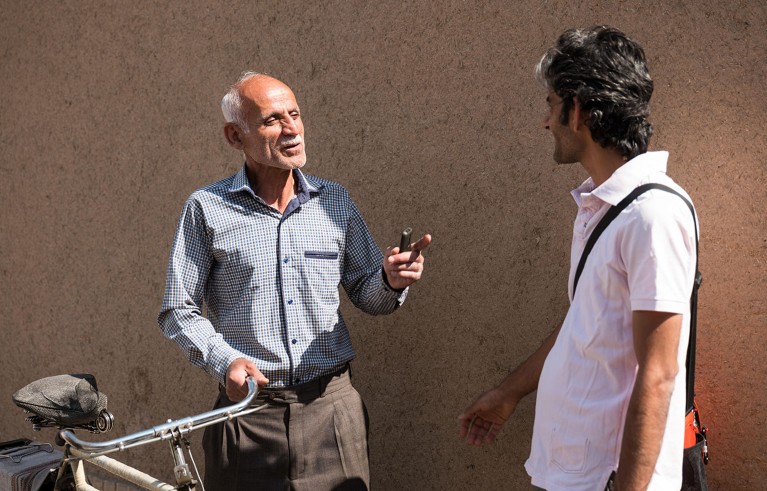
Languages including Farsi are members of the globe-spanning Indo-European language family.Credit: Tina Manley/Alamy
Ancient-genomics researchers have pinpointed the homelands of a nomadic tribe that transformed the culture and genetics of Europe and Asia, revealing a potential source for the Indo–European language family, spoken by much of the world.
Genomes from more than 400 individuals suggest that the Yamnaya — Bronze Age herders from the steppes of present-day Russia and Ukraine — emerged along the northern shores of the Black Sea. The findings are published on 5 February in Nature12.
“I think they are truly groundbreaking,” says Kristian Kristiansen, an archaeologist at the University of Gothenburg in Sweden. “This really solves two big unresolved questions.” The first is the origin of the Yamnaya.
The second was posed in the eighteenth century, when scholars noticed similarities between classical Greek and Latin and Sanskrit, an ancient language from South Asia, and suggested a common origin.
Nearly half the world’s population speaks at least one of the roughly 400 Indo–European languages. These include nearly all European and Central Asian languages, as well as those from South Asia and Iran.
“This Indo–European story has been mystery for 200 years, and now step by step, we are coming closer to the solution,” says Volker Heyd, an archaeologist at the University of Helsinki.
‘Tracer dye’
For decades, the leading theory for the ubiquity of Indo-European languages was that early farmers, living in a region known as Anatolia, which includes present-day Turkey, exported languages in the family as the agricultural revolution spread starting around 9,000 years ago.
The ‘Anatolian hypothesis’ took a blow in 2015, when two blockbuster ancient-genomics papers identified a migration of Yamnaya herders across Eurasia beginning 5,500 years ago3,4. This and subsequent work showing the arrival of ‘steppe’ ancestry in most places that Indo–European languages are spoken was ammunition for the ‘steppe hypothesis’ that Yamnaya were responsible for seeding Indo-European languages far and wide.
“Yamnaya ancestry is like a tracer dye whose spread you can connect with Indo-European language spread,” says David Reich, a population geneticist at Harvard Medical School in Boston, Massachusetts, who co-led the latest studies.

The region around the Caucasus mountains, between Europe and Asia, was home to people who spoke the earliest Indo-European languages.Credit: Yuriy Pozdnikov/Alamy
But even with the genetic evidence, the steppe hypothesis had a major problem: how to explain the Anatolian branch of Indo–European — some scholars use the term Indo–Anatolian — which includes Hittite, a language used by a civilization that flourished in modern-day Turkey in the second millennium BC. Geneticists have failed to find Yamnaya ancestry in ancient Anatolian speakers.
In search of that connection, Reich and his colleagues hoped to identify the genetic origins of the Yamnaya. This has been a challenge because of the group’s rapid expansion of a nearly identical genetic signature. “It looks like a kind of cancer tumour, and you can’t say where the origin of the tumour is because it expanded so fast,” says Reich.
To overcome this, Reich and his colleagues, including scientists in Russia and Ukraine, generated genome data from 428 ancient individuals, including hundreds of Yamnaya people and individuals who predated them living across the steppe and further southeast along the Caucasus mountains.
Route to Anatolia
The approach identified a genetic signature in people living in a region between the Caucasus mountains and the lower Volga River to the north that connects the earliest Yamnaya and ancient Anatolians. Reich’s team found that the Yamnaya emerged when people with Caucasus-Lower Volga ancestry moved west around 6,000 years ago and mixed with a diverse group of hunter-gatherers living along the Black Sea. The same Caucasus-Lower Volga ancestry also appeared in ancient Anatolia around this time.
Based on this evidence, the researchers think that the earliest Indo-European languages were spoken by people living in the Caucasus–Lower Volga, who then carried them to Anatolia and to the Black Sea steppe, where the Yamnaya and their descendants spread them still further.
The geneticists stress that migrations aren’t the only way languages transmit, and that their work provides a hypothesis for others to test. “This is a very good case for the solution to the Indo-European problem,” says Iosif Lazaridis, a Harvard population geneticist who co-led the studies. “But we can’t prove these people spoke Anatolian language because they’re not buried with tablets saying I’m an Anatolian speaker.”


